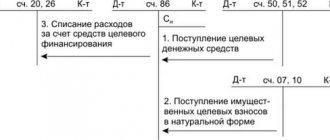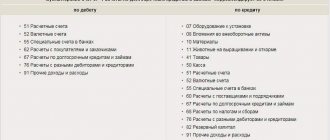What is account 60 in accounting?
According to the chart of accounts (approved by order of the Ministry of Finance dated October 31, 2000 No. 94n), account 60 is called “Settlements with suppliers and contractors.” It reflects all transactions related to the acquisition and payment of inventory, work, and services. Here are a few special cases:
- consumption of electricity, gas, water, etc.;
- identification of surplus inventory items upon their acceptance;
- purchasing delivery and communication services;
- uninvoiced deliveries (for which documents were not received from the sellers).
Count 60 is active-passive. The balance on it can be either debit or credit. Increases and decreases in funds can be shown either by debit or credit (for more details, see: “Chart of Accounts in 2021”).
Analytical accounting is usually organized by suppliers, contractors and invoices issued by counterparties. Sometimes, depending on the specifics of the company, analytics are carried out in the context of contracts, products, etc. The main thing is to have access to information about overdue debts to sellers, as well as about debts that have not yet matured.
Maintain accounting and tax records for free in the web service
What is account 60 used for in accounting?
The current Chart of Accounts establishes that settlements with suppliers and contractors must be carried out using account 60.
Here, transactions involving the receipt of goods, works, services from counterparties, and the amount of allocated VAT are recorded, if these companies work with VAT.
The use of account 60 involves reflecting on it advances for the next receipt of goods, as well as making payments for material assets already received or services rendered, work performed.
Attention! Thus, the information reflected on account 60 allows you to find out the status of mutual settlements with each supplier, and the balance on the account reflects either the amount of debt that the company must transfer to these companies, or the cost of goods, works and services expected to be received.
The same account reflects material assets that came to the company without documents being issued for them from suppliers, that is, uninvoiced supplies.
What does the debit of account 60 reflect?
Debit turnover is the amount that the organization paid to its partners - suppliers. These amounts include payment for completed deliveries (they are carried out under subaccount 60.01) and advances to sellers (they are carried out under subaccount 60.02).
REFERENCE . A debit balance on account 60 most often indicates that the company has transferred an advance payment, but the counterparty has not yet made the shipment (did not perform the work, did not provide the service). As a result, the seller has a debt to the organization.
Balance sheet for account 60
Account 60 is active-passive, that is, it can simultaneously contain both debit and credit balances. In order to track their formation, it is advisable to keep records for each supplier.
Modern software products for accounting allow you to build registers to review calculations for the general account, for subaccounts, and also allow you to create a balance sheet for each individual supplier.
The balance sheet for account 60 is an accounting register. The law does not define a special form for this type of document, but it establishes a list of mandatory details:
- Company name, register name;
- Start and end date of the register, period of compilation;
- The value of monetary measurement;
- Signatures and names of responsible persons.
When creating a statement for account No. 60, you must adhere to the following rules:
- When generating debit turnover, all operations to repay the debt to the supplier, or prepayment for work or services are indicated there. It is also necessary to indicate here information about all payment documents - orders or cash settlement orders on the basis of which the payment was made. Also in this turnover it is necessary to show the operations of offset of claims, as well as the return of goods to the supplier.
- When forming credit turnover, all operations for the acquisition of inventory and materials from the supplier are indicated here - goods, works, non-current assets, etc. Also here you need to show all the primary documents on the basis of which the goods or services are posted - delivery notes, invoices, etc. etc. Also in this turnover you need to enter returns from prepayment suppliers for unfulfilled deliveries.
What does account credit 60 reflect?
Loan turnover is the cost of supplies received from the counterparty. If the shipment goes against a previously made advance, it is carried out according to subaccount 60.02. If payment has not yet been made, delivery is carried out using subaccount 60.01.
When the seller is on the general taxation system and pays VAT, the input value added tax is also reflected on the credit of account 60.
REFERENCE. Credit balance on account 60 means that the counterparty has shipped the product (provided a service, performed the work), but the company has not yet paid it off. As a result, the organization owes a debt to the supplier.
List of accounts involved in accounting entries:
|
|
| Account Dt | Kt account | Wiring Description | Transaction amount | A document base |
| Postings reflecting the accounting for the supply of materials with payment to the supplier after receipt of the materials | ||||
| 10 | 60.01 | The receipt of materials from the supplier to the organization's warehouse is reflected. Subaccount 10 is determined by the type of materials received | Cost of materials excluding VAT | Consignment note (form No. TORG-12) Receipt order (TMF No. M-4) |
| 19.3 | 60.01 | The amount of VAT related to the materials received is reflected. | VAT amount | Consignment note (form No. TORG-12) Invoice |
| 68.2 | 19.3 | The VAT amount applies to reimbursement from the budget. Posting is done if there is a supplier invoice | VAT amount | Invoice Purchase book Consignment note (form No. TORG-12) |
| 60.01 | 51 | The fact of repayment of accounts payable to the supplier for previously received materials is reflected. | Purchase price of goods | Bank statementPayment order |
| Postings for accounting for the supply of materials on prepayment | ||||
| 60.02 | 51 | Prepayment to the supplier for materials is reflected | Advance payment amount | Bank statementPayment order |
| 10 | 60.01 | The receipt of materials from the supplier to the organization's warehouse is reflected. Subaccount 10 is determined by the type of materials received | Cost of materials excluding VAT | Consignment note (form No. TORG-12) Receipt order (TMF No. M-4) |
| 19.3 | 60.01 | The amount of VAT related to the materials received is reflected. | VAT amount | Consignment note (form No. TORG-12) Invoice |
| 68.2 | 19.3 | The VAT amount applies to reimbursement from the budget. Posting is done if there is a supplier invoice | VAT amount | Invoice Purchase book Consignment note (form No. TORG-12) |
| 60.01 | 60.02 | The previously transferred prepayment is offset against the debt for the materials received. | Purchase cost of materials | Accounting certificate-calculation |
Accounting entries for account 60
DEBIT 41 (07, 08, 10) CREDIT 60 - goods received and capitalized (equipment, non-current assets, materials)
DEBIT 20 (25, 26) CREDIT 60 - work and services written off to the cost of products (for general production, general business expenses)
DEBIT 19 CREDIT 60 - input VAT reflected
DEBIT 94 CREDIT 60 - the shortage identified during acceptance of inventory items is reflected
DEBIT 60 CREDIT 50 (51) - payment made to the supplier
DEBIT 60 CREDIT 91 - overdue accounts payable written off as other income
DEBIT 60 CREDIT 62 - mutual settlement with the counterparty has been made.
Fill out and print your balance sheet using the current form for free
Features of accounting and characteristics of accounting
This accounting account belongs to the group of active-passive accounting accounts. This means that both the debit of account 60 and the credit are subject to the ending balance. Now we will give a detailed explanation for beginners in the accounting field of what accounting account 60 looks like for dummies: in the example we use a fictitious one.
Vesna LLC entered into two agreements:
- According to the terms of agreement No. 1, supplies of goods and materials by a third-party company are carried out before payment. Consequently, the receipt of material assets in the accounting of Vesna LLC will be reflected in the credit of accounting account 60 as an arising obligation.
- Under the terms of agreement No. 2, Vesna LLC undertakes to make an advance payment for the ordered services and work. In such a situation, the advance transferred in favor of the supplier or contractor is taken into account as a debit to accounting account 60.
The company is obliged to organize reliable and detailed analytical accounting in the context of each third-party company, entrepreneur and individual. In other words, all suppliers and contractors (account 60) are reflected separately; In addition, it is necessary to provide details on contracts and agreements.
Accounting for settlements with suppliers and contractors
The use of account 60 “Settlements with suppliers and contractors” is regulated by the Chart of Accounts, approved by Order of the Ministry of Finance of the Russian Federation dated October 31, 2000 No. 94n. This account is necessary to reflect data on payments for:
- goods, works, services (hereinafter referred to as GWS), which were accepted from the supplier and for which primary documents were received;
- GWS that were accepted from the supplier, but for which primary documents were not received (uninvoiced deliveries);
- surplus capitalized upon receipt of goods;
- work accepted from subcontractors, etc.
Operations to reflect accounts payable are carried out at the moment the obligation arises; the moment of payment does not affect the entry on the credit of account 60 in accounting . When to show a liability in accounting depends on the conditions for the transfer of ownership of the purchased GWS in accordance with the agreement between the buyer and supplier. The reflection of the obligation in accounting occurs at the same time as the reflection of the receipt of goods and services. When capitalizing the goods and services, the accountant records the transaction on the credit of account 60 and on the debit of the accounts of purchased property (as well as account 15) or costs for the amount specified in the supplier’s primary documents. VAT, included in the cost of goods and services, is allocated separately by posting:
Dt 19 Kt 60.
When obligations are fulfilled, that is, payment is made to the supplier, an entry is made for the amount of payment:
Dt 60 Kt 50, 51, 52, 55.
If the buyer makes payment before delivery of goods and materials, the posting is recorded as a debit to account 60 of the “Advances issued” subaccount. Thus, accounts receivable are accumulated in a separate subaccount of account 60, which will be repaid upon receipt of goods and services. At the same time, in the balance sheet, accounts payable for account 60 are shown as a liability, and accounts receivable are shown as an asset, and therefore the collapsed balance of account 60 cannot be shown in the reporting.
If the buyer transfers his own bill of exchange as a guarantee of payment of goods and services, then accounts payable from account 60 are not written off, but are reflected in a separate sub-account, for example, by posting:
Dt 60 subaccount “Settlements for received technical and technical materials” – Kt 60 subaccount “Settlements for bills issued”.
When repaying your own bill, the following posting is made:
Dt 60 subaccount “Settlements on bills issued” – Kt 50, 51, 52, 55.
HIGHLIGHTS OF THE WEEK
01/30/20216:18 Special modes
Answers to questions from the Federal Tax Service for individual entrepreneurs on a patent
03.02.202115:11
Personnel
A new “coronavirus” payment has been established
02.02.202110:57
Checks
Consolidated inspection plan for 2021 published
01.02.202112:00
Personnel
Amounts of child benefits for 2021. Table
01.02.202110:01
Special modes
Reduce the patent for contributions: a notification form has appeared
PODCAST 4.12.2020
What has changed in taxes and reporting since 2021?
All episodes
Comments on documents for an accountant
Workers in “harmful” jobs are idle: should they pay additional tariff contributions?
02/05/2021 If employees performing work under dangerous and difficult conditions are idle, payments for this…
Payment for employee meals is free of insurance premiums
02/05/2021 If subsidies for employee meals are of a social nature, insurance premiums need not be paid...
Is it possible to apply NAP when assembling and selling computer systems?
02.02.2021 Federal legislation establishes a list of types of activities for which it is permitted to use...
‹Previous›Next All comments





